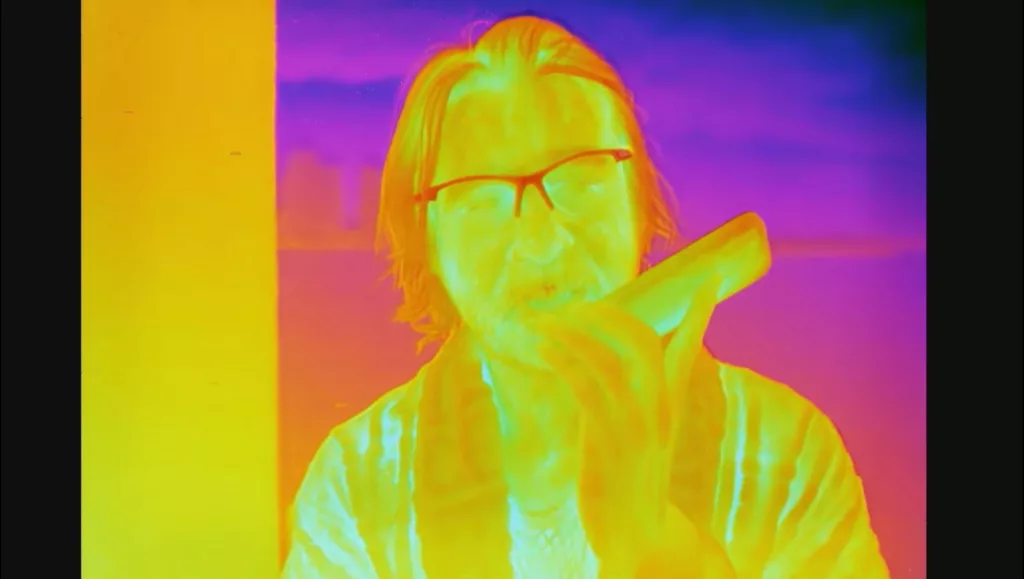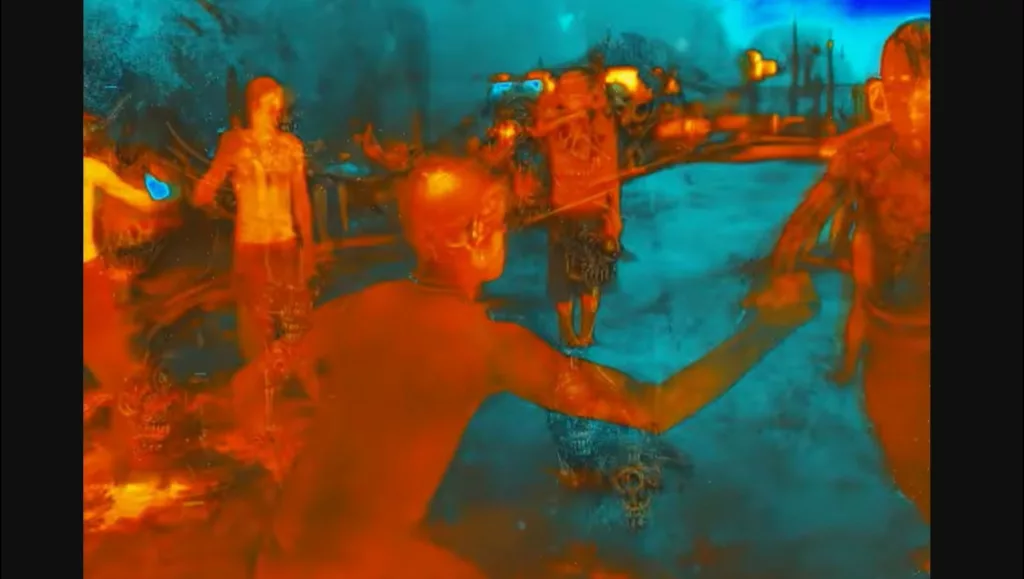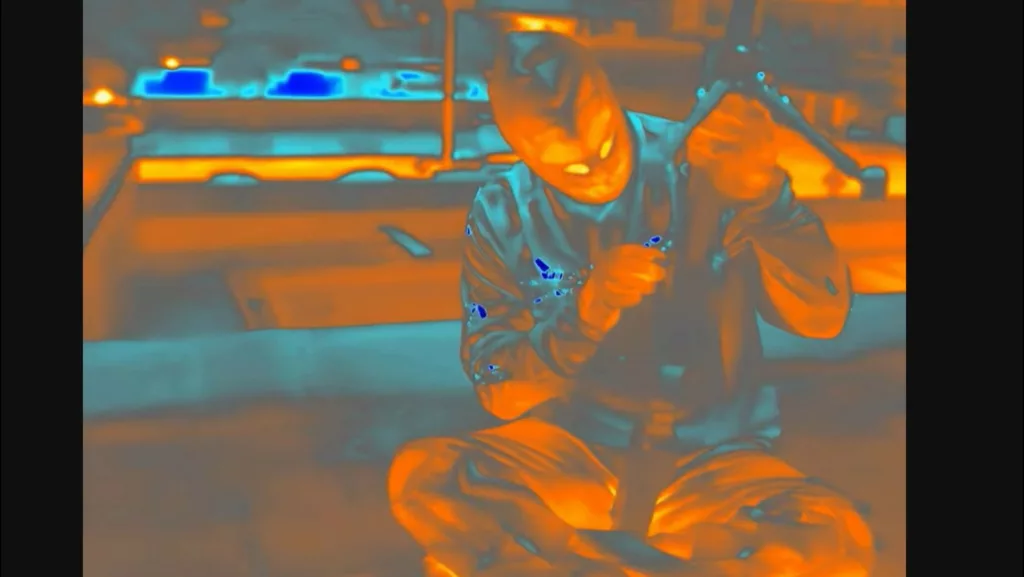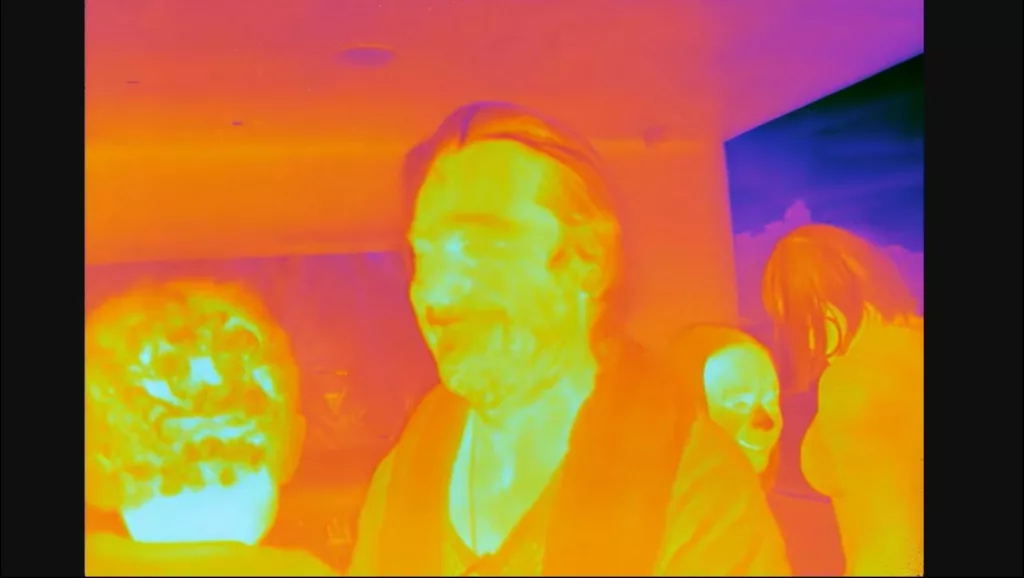Renowned auteur Harmony Korine has never been one to play it safe or follow conventions. Since bursting onto the scene with Kids in the 1990s, the provocateur has tested limits with films like Gummo, Julien Donkey-Boy and Spring Breakers. His latest, Aggro Dr1ft, promises to be his most challenging work yet in its defiantly experimental approach.
Shot entirely using thermal cameras, Aggro Dr1ft blends genres as it tells the story of a world-class assassin named Bo. The infrared cinematography lends Korine’s Miami setting an otherworldly, hallucinatory feel, with characters rendered as pulsating clouds of surreal colors. But beyond its stunning visuals, Aggro Dr1ft rejects traditional narratives, instead crafting a sensory onslaught of images, sounds and dialogue that draw from video games, music videos and the frenetic rhythms of today’s online world.
Korine considers Aggro Dr1ft not a film but a “blinx”—an immersive, anything-goes experience unbound by box office expectations or easy answers. Divisive from the start after its Venice Film Festival premiere, it strives to provoke through absurdist extremes. Whether celebrating or condemning toxic masculinity depends on the viewer. One thing is clear: with Aggro Dr1ft, Korine has left conventions far behind in search of new cinematic frontiers sure to spark passionate discussion.
Flickering Dreams of Violence
Within the infrared haze of Aggro Dr1ft, hitman Bo receives an unusual contract—to hunt down the demonic crime lord Toto. Little else is clear in Harmony Korine’s boundary-pushing blend of grindhouse thrills and artful abstraction.
Bo prides himself as “the world’s greatest assassin,” yet his latest target poses an elusive challenge unlike any before. Toto operates from a sprawling Miami estate, shrouded in mystery. With a faceless skull mask and massive bat-like wings, he strikes an unsettling figure—half-man, half-myth. A gang of creepy child soldiers call him master, while bikini-clad “bitches” serve his savage whims indoors and out.
Information proves scarce, but Bo’s employer needs the beast eliminated. And so our taciturn antihero slips into the neon night, infrared cameras tracing his movements in a hypnotic swirl of colors. Between hits, he returns home to cherish his devoted wife, grounding himself amid the chaos. Yet his voice drifts in and out of robotic riddles that blur reality’s edges.
Violence arrives in sensory surges—a beheading explodes in gory spray, machine-gun fire crackles through lavish estates. But Korine purposefully blurs the lines between fact and fiction, man and machine, life and death.
He lets his Miami mutate into a trippy fever dream where nothing is as it seems. Plot matters less than the hypnotic imagery and pounding electronics that immerse viewers in the disorienting adventure. Through it all, Bo and Toto remain locked in a battle as abstract as the dizzying odyssey containing them both.
Visual Highs and Lows
Harmony Korine’s Aggro Dr1ft boasts a truly novel visual style thanks to its innovative cinematography. Shot using thermal infrared cameras, the film transports viewers to a surreal realm where everything pulsates in vivid yet disorienting hues. Characters emerge as towering crimson silhouettes or wispy azure shadows, their bodies continually shifting between abstract forms.
It’s an undeniably psychedelic experience. Scenes glow with supernatural colors, from smoldering pink skies to toxic lime green waters. However brilliant in isolated moments, the kaleidoscopic effects can grow exhausting over the film’s duration. Dialogue and tangible details sometimes fade into the feverish palette. Despite its ambitions, the infrared lens risks reducing the world to a lavish but illegible light show.
Where the style showing shines is in its uncanny glimpses beneath flesh. During scenes of violence or intimacy, figures resonate with ghostly mechanics. Veins bulge like circuitry; bones gleam robotic. It casts them simultaneously as soulless killing machines and vulnerable androids – a provocative reframing of humanity. These flashes of X-ray vision, hinting at characters’ dual nature, represent high points of the visual motif.
Yet for all its hallucinatory aesthetic, Aggro Dr1ft falls flat as a true immersive experience. While clearly evoking the textures of games, its first-person ambitions amount to style over substance. Little dynamism or interactivity emerges from its static wide shots. The detached camera floats but does not feel situated within this vivid yet vacant digital realm. Thus for some, the visual fireworks ring hollow without real engaging substance – all sizzle, no steak.
Overall, Korine takes daring strides with his technical experimentation. But beyond fleeting moments of intrigue or beauty, the film’s visual language ultimately communicates more style than meaning. Aggro Dr1ft remains an enticing technical achievement that, for better or worse, prioritizes surface spectacle over grounded storytelling. Its visuals divide as much as they transport, leaving viewers stranded in a dazzling yet coldly incoherent vision of the future of cinema.
Into the Fray
Bo drifts through a technicolor fever dream, his infrared vision rendering the world in pulsing reds, pinks and purples. As the world’s greatest assassin, he is a “solitary hero” cut off from normal ties, carrying out high-risk jobs in a lawless criminal milieu. His targets are not merely men but “demons” embodying primal forces that must be vanquished.
There is an unease to Bo’s solitary role, as he seeks balance between his lethal profession and deep love for his family. While providing for his wife and children, his work leaves no place for tenderness in his day to day. The film visuals reflect this conflict, often overlaying Bo’s form with intricate mechanical skeletons or circuitry, the man merging ambiguously with machine.
Miami appears a place where such lines freely blur. Criminals cloak their dehumanizing actions in shades of performative masculinity and power worship. Toto and his cohorts objectify women as “bitches” to be caged or commanded. Even Bo’s rhetoric takes on macho bravado as he declares himself “the world’s greatest.” Violence is normalized yet also aestheticized, from gun fetishization to gory kills depicted like abstract art.
Korine seems to interrogate the roots of such behavior. By rendering the world in a hallucinatory, alien palette and characters as partly robotic, he estranges familiar tropes, questioning how authentic such exaggerated masculine identity really is. Into this murky realm of shifting forms and values, Bo drifts alone, navigating the only path he knows to find purpose amid the fray.
Exploring Perspectives
Jordi Mollà takes on the demanding lead role of assassin Bo in Harmony Korine’s experimental film. Through Bo, we glimpse multiple sides of a complex character. As a devoted family man, his love for his wife and children comes through in touching scenes. Yet as a “solitary hero” driven to violence, we see the toll this conflicted life must take.
Bo’s introspective voiceover gives us insight, but through repetition perhaps reflects the character’s inner struggles to reconcile his roles. Mollà commits fully to exploring this dichotomy, keeping us engaged in Bo’s journey.
Travis Scott also brings an unconventional energy as Zion, Bo’s apprentice. His brief but buzzing appearance captures the young recruit’s mix of mystique and unease.
Some have criticized the one-dimensional portrayals of women. While their roles could have depth, consider how they may represent the objectification Bo and others grapple with in their world. A critique, but also an attempt at verisimilitude?
Overall, the film aims to shed light on multifaceted lives, not pass simple judgment. In undertaking complex, sometimes unsettled characters, the actors open windows into deeper discussions around masculinity and society’s impact on the human spirit. Their daring performances keep viewers examining hard questions long after leaving the theater.
A Technically Daring Work That Both Provokes and Falters
Harmony Korine’s Aggro Dr1ft is many things – a fever dream come to life, an experiment in sensory overload, and a boundary-pushing departure from traditional cinematic norms. Shot entirely in infrared, the intensely colorful yet disorienting visuals immerse viewers in a nightmarish neon world unlike anything previously seen on screen. When it hits its stride, the hypnotic cinematography and pulsating score transport the mind to a place of pure abstraction, losing oneself in the swirling textures and hallucinatory forms.
However, Korine pushes his vexing concept too far at times. The thin plot and repetitively banal dialogue threaten to derail the hypnotic atmosphere. Scenes drone on without purpose, diminishing the engrossing quality of the surreal vistas. Additionally, problematic elements undermine its artistic intentions. Rife with misogynistic objectification and mindless violence, the film risks glorifying the very toxically masculine ideals it seems to critique.
While undeniably experimental and technically ambitious, Aggro Dr1ft falls short as a fully coherent cinematic story. The meandering pace and superficial characters prove disengaging over the feature-length runtime. Yet viewed not as a traditional narrative film but as an unsettling sensory odyssey, it makes for a challenging and unforgettable experience.
Perhaps Korine’s cutting-edge vision is better appreciated as installation art rather than conventional cinema. Ultimately, Aggro Dr1ft pushes boundaries, for better and worse – a work that both provokes and falters in its unyieldingly strange execution.
Aggro Dr1ft: An Unmissable Oddity
Harmony Korine’s latest project Aggro Dr1ft is nothing short of a boundary-pushing oddity. A sensory assault of sound and images that amalgamates influences in fresh and disorienting ways, it strives to create something wholly new yet deeply familiar. The experience is at once dazzling and difficult, exhilarating and wearisome. There is no doubt the film will spark passionate debates and divide audiences.
Aggro Dr1ft pushes creative limits through its audacious infrared cinematography, pulsing colors, and non-linear narrative. The visuals immerse viewers in a nightmarish yet striking vision of its criminal underworld. Meanwhile, the protagonist’s reflections turn clichés on their head to ponder humanity’s place in an increasingly chaotic reality. Korine ensures no moment is wasted aiming to provoke and confuse.
Ultimately, Agnro Dr1ft refuses simple categorization. It can be appreciated as a daring experiment or criticized as a stunt. Reactions may vary significantly depending on a viewer’s mood and mindset. However uncomfortable certain aspects may be, its complete unwillingness to conform cannot be denied.
For those eager to witness the boundaries of cinema expanded, Aggro Dr1ft offers a one of a kind trip into uncharted artistic territory. While not an easily digestible watch, the film deserves to be seen for its unbridled creativity and ambition alone. A truly unmissable cinematic oddity awaits those open to its challenges and provocations.
The Review
Aggro Dr1ft
Harmony Korine's Aggro Dr1ft is a defiantly unconventional work that will not appeal to all. However, one cannot deny its importance as a bold artistic statement push creative boundaries in visual storytelling. Through its disorienting sensory assault of sounds and imagery, Aggro Dr1ft immerses viewers in a unnerving yet visually arresting vision of its criminal underworld. It leaves an undeniable mark through its fearlessness in tackling provocative subject matter and willingness to confuse and divide audiences. While certainly not a seamless or pleasant watch, Aggro Dr1ft's complete refusal to conform and unbridled creativity ensure it will be a discussed and debated long after.
PROS
- Highly original and boundary-pushing visual style through innovative infrared cinematography
- Unafraid to tackle provocative themes and leave audiences confused/challenged
- Immersive sound and image assault ensures it stands out unforgettably
- Ambitious in striving to create something wholly new through formal experimentation
CONS
- Highly nonlinear narrative and repetitive dialogue make the plot difficult to follow
- Controversial or problematic depictions of women may turn some viewers away
- Demanding and exhausting experience that is not for those seeking traditional entertainment
- Frustratingly lacks cohesion at times despite creative flashes





















































